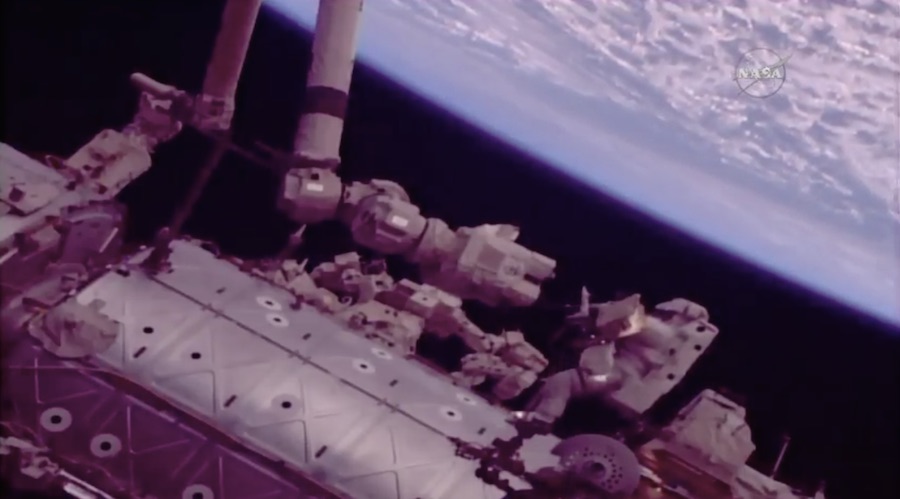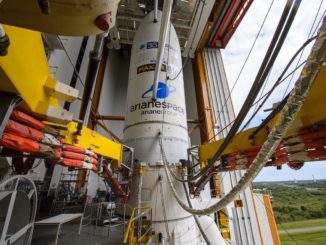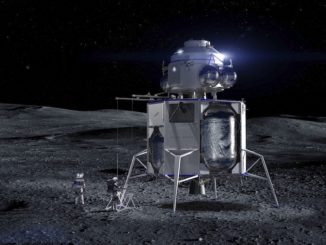STORY WRITTEN FOR CBS NEWS & USED WITH PERMISSION

Astronaut Mark Vande Hei and Japanese crewmate Norishige Kanai floated outside the International Space Station Friday, repositioned two robot arm grapple mechanisms following repair work last month and carried out a variety of “get-ahead” tasks before calling it a day.
Floating in the Quest airlock, Vande Hei and Kanai switched their spacesuits to battery power at 7 a.m. EST (GMT-5), officially kicking off a planned six-and-a-half-hour spacewalk. After opening the airlock’s hatch and rigging safety tethers, they made their way outside as the station passed 250 miles above northern South America.
The spacewalk was the third over the past four months devoted to overhauling the station’s robot arm.
Each end of the arm is equipped with a complex grapple mechanism, known as a latching end effector, or LEE, that uses motorized snares to lock onto anchor fittings and plug into power, data and video connectors.
The arm can move end over end like an inchworm, anchoring itself to powered fittings around the U.S. segment of the station, or it can mount itself on a mobile transporter that can carry the arm to work sites along the lab’s main power truss.
The arm is critical to station operations. It is routinely used to move spacewalking astronauts and components about the station’s exterior and it is required to capture visiting U.S. cargo ships, pulling them in for berthing and later releasing them from the station.
The arm was launched to the station aboard a space shuttle in 2001 and several years ago, engineers noticed signs of wear and tear in both LEE mechanisms. During two spacewalks in 2015, astronauts lubricated the internal snare mechanisms to reduce friction, extending the useful life of both grapple fittings. But engineers knew the units would eventually need to be replaced.
Last October, Vande Hei and Randy Bresnik replaced one aging grapple mechanism — LEE-A — and during an outing last month, Vande Hei and Scott Tingle replaced LEE-B with a spare that was launched in 2009.
The degraded LEE-A was temporarily stowed on a powered anchor fitting known as a POA on the station’s mobile transporter. During Friday’s spacewalk, Vande Hei and Kanai detached the mechanism and hauled it back to the airlock.
It will eventually be returned to Earth aboard a SpaceX Dragon cargo ship, refurbished and re-launched. Another spare LEE currently is awaiting launch.
The still-functional LEE-B mechanism that was removed last month was temporarily mounted on an external storage platform. Vande Hei and Kanai moved it up to the mobile transporter where it was mounted in place of LEE-A for use as needed in the future to hold components in place.
“Worth noting, these original Canadarm 2 LEEs both comfortably exceeded their design expectation, lasted years longer than we thought they were going to,” said Tim Braithwaite, a Canadian Space Agency liaison officer at NASA. “So we’re really pleased with that.”
Flight controllers blocked out four hours and 45 minutes to complete the LEE repositioning work, but Vande Hei and Kanai finished the job in about two-and-a-half hours. That left plenty of time for the astronauts to carry out several lower-priority get-ahead tasks.
Vande Hei applied lubrication to the robot arm’s new LEE-B mechanism, the one installed last month, while Kanai deployed a tool-like fixture on a robot arm extension known as the Special Purpose Dexterous Manipulator, or DEXTRE. He also ttached electrical grounding straps to the arm’s LEE-A fitting, the one installed last October.
Finally, Vande Hei repositioned a strut supporting a flexible hose assembly on the external stowage platform. At that point, they decided to call it a day, returning to the airlock and repressurizing to officially end a five-hour 57-minute excursion.
Friday’s spacewalk was the 208th devoted to station assembly and maintenance since 1998, the first of up to 12 U.S. and Russian EVAs planned for 2018, the fourth for Vande Hei and the first for Kanai, who is the fourth Japanese astronaut to walk in space.
More than 120 astronauts and cosmonauts have now logged 1,299 hours and 59 minutes of spacewalk time — 54.2 days — building and maintaining the International Space Station.



